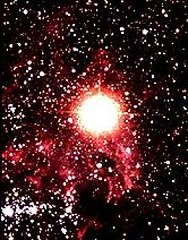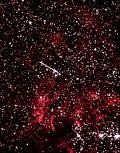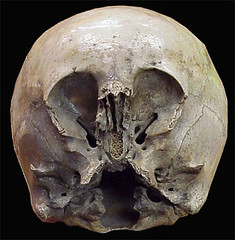Star Child
Insignificant
You gaze at the stars on a warm balmy evening. There is silence, not a thing to be heard. You fill with wonder. Astronomy, stars, double stars, universe, what's it all about?
It’s so huge up there. You feel insignificant, a speck, nothing. Astronomy makes us small. Surely we're not alone, there must be life out there? Some people are adamant there is. Lloyd Pye, researcher, is one of them.
The Star child Skull
The so-called Star child skull is that of a five-year-old female. It was found in a cave in Mexico in the early 20th century, lying by the side of the skeleton of an adult female.
Carbon dating has sited it as around 900 years old. The star child was apparently quite extraordinary. The skull is much larger than usual and the eye sockets shallower. At the back, the skull is extraordinarily flat, reaching downward much further than a conventional human skull. The Star child skull also has a brain capacity 200cc higher than that of a normal adult skull.
Made of stardust
When the remains were brought to the notice of Lloyd Pye, he was fascinated. As far as he was concerned, the skull could not relate to any ordinary human head. Was this the skull of an alien? It was what he’d been hoping for, wishing for.
Yet, he didn’t have to look far to find a star child. He could have looked in the mirror, or looked at you. YOU are a child of the universe; you are a star child. You’re made of stardust. Wow! Never!
Supernova Supernova
But it’s true. Every cell in your body is made from stardust. Look out at the sky tonight, gaze on the stars – you are part of them – intricately connected.

One of the most powerful explosive performances ever staged is a supernova. It takes place at the closing stages of the life of a massive star. Its nuclear fuel is worn out; the delicate balance no longer glued together by the discharging of nuclear power and it starts to collapse. If the star is above a critical mass, its heart will crumple and in so doing will liberate an enormous quantity of energy. This triggers a detonation that hurtles the mantle into interstellar space.
Interstellar dust
4.5 billion years ago, one such star went into supernova, spewing heavy-element wreckage into a neighbouring cloud of hydrogen gas and interstellar dust. Hydrogen - the simplest element possible - food of nuclear fusion. The concoction compacted under its own gravity, and at its centre, feeding on the new supply of hydrogen, a new star began to form and around it swirled a halo of similar matter.
That new star became our Sun. The halo gave rise to Earth and its sister planets.
While the Sun grew in mass and power, the halo surrounding it slowly cooled. Over millions of years, the matter began to freeze into grains of metal and compounds of silicon, magnesium, aluminium, and oxygen.
Slowly these collected into clusters, then chunks, then boulders, and finally bodies large enough to exert their own gravity. The larger gravitational forces attracted more debris - which increased the mass to give even larger gravitational forces - and so planets began to form.
The more dense matter settled in the centre, whilst the lighter separated into a mantle, a miniature version of the Earth and the other inner planets today.
Planetologists. specialist astonomers call this differentiation, and it is documented not only for the planets, but also for most of the large moons and the largest asteroids. The asteroids Ceres, Pallas and Vesta survive from that time - miniature planets.
Earth was born
And from Earth grew life – life made up of atoms and molecules generated and spewed from that supernova – life made from stardust.
Everything around you, every blade of grass, every flower, every insect - everything that is you, is a direct result of stardust from that supernova.
Welcome child of the universe - welcome star child.
--------------------------------------------------------------------------------------
For your next $0.99 Kindle book, why not try:






